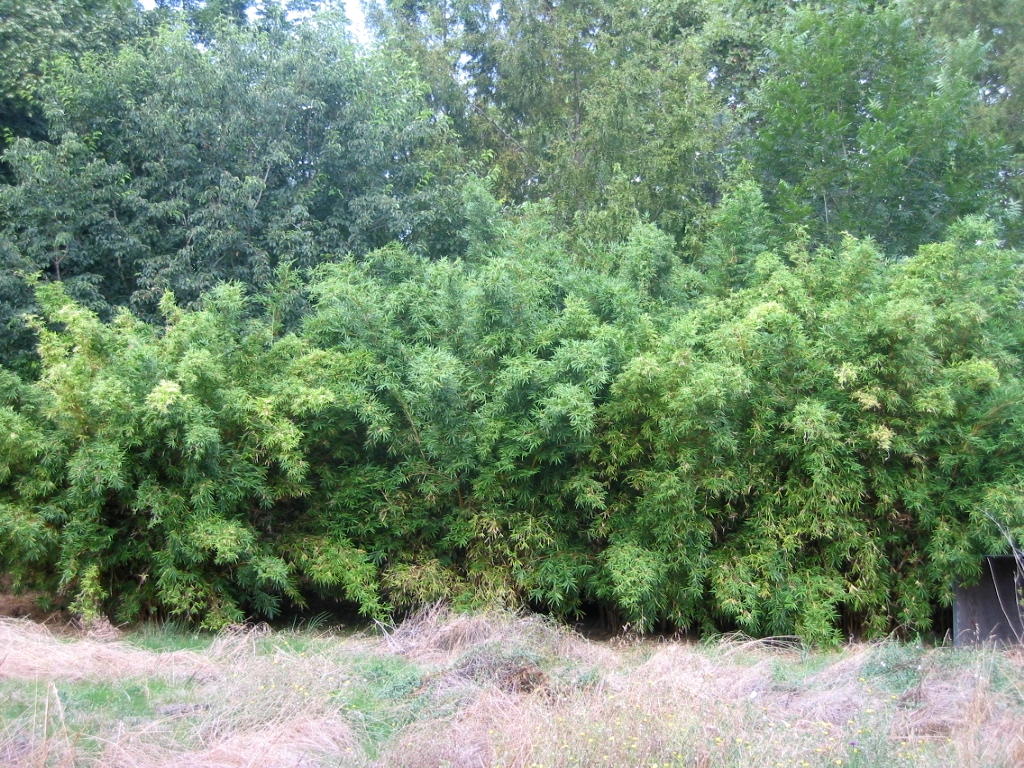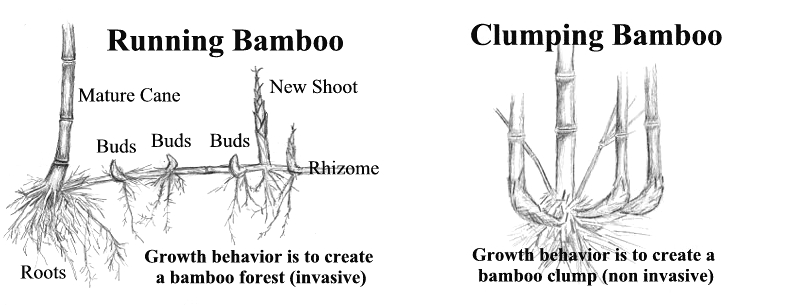
Phyllostachys species showing ridge on culm. It's easy to tell running from clumping bamboo: runners always have a ridge or groove on the culm, whereas culms of clumpers are perfectly round. Check the label: in this area, most common runners are in the genus Phyllostachys. Most common clumpers are in the genus Bambusa. But bamboo can be mislabeled, so it's wise to double-check!
|
Can running bamboo be controlled?
Yes, but any method of confinement must be monitored. The rhizomes grow in a straight-ish line, and if they hit a barrier they will grow along it, under it, or over it. Bamboo barriers are made of 40 - 60 ml plastic, installed in a trench and left sticking up a couple of inches above ground. Walk the line every year and snap off any rhizomes that have grown over the barrier. Don't allow leaf debris to build up over the barrier, or rhizomes will happily push unnoticed through the leaf mold and root as they do so.
Some other options:
o Bamboo can be planted in lawn areas and maintained by keeping the grass clear for several feet past the grove, usually with herbicides. Rhizomes and shoots that show up are then dug out. Done annually, this isn't too arduous.
o Concrete contains bamboo, although rhizomes have been known to grow along the expansion joints that are left in paths and driveways.
o A trench filled with coarse gravel or cobble provides a visible line to follow and watch for rhizomes.
o Rhizomes will not grow into dry soil, so unirrigated areas provide a natural barrier. Rhizomes also will not grow far into open water. A moat or pond can contain them.
o Running bamboo is excellent in a container. The rhizomes simply circle around and around, eventually getting quite root-bound, so the plant will need frequent watering after the first year or so. But bamboo can survive and look attractive for many years, even when totally root-bound.
Of course, it is simpler to just plant clumping bamboo in the first place.
How do I get rid of running bamboo?
From an article my father wrote for the American Bamboo Society years ago:
"Cut it off.
Cut it down.
Water the area.
Cut it down again.
And again."
Plant the right bamboo next time!
Cut it off: cut the rhizomes to separate the plant from the main source (your neighbor's bamboo). Cut it down: cut all the culms to the ground. Rhizomes that don't have leaves to support them will slowly starve. But they resprout quickly, so water the area to get them to do so. Then cut them down or dig them out again, as many times as necessary.
Will herbicides help during this process? Possibly. Many people use glyphosate to try to kill the root system. It works best, if at all, when it is sprayed on as much leaf area as possible. Bamboo has a lot of stem, and the leaves are way up high. So it is best sprayed when it has been cut and resprouted to make the leaves more accessible. Applying herbicide to the cut stems doesn't really work.
How do I plant a bamboo hedge?
Clumping bamboos make the best hedges, as they have the leaf density you are after. Varieties of Bambusa multiplex are most effective, to the point they are often called "hedge bamboos."
The expensive way is to buy a bunch of clumping bamboo plants and install them 4 - 5 feet apart. They will double in height each year, and expand slowly outward, creating a wall of bamboo in a couple of years. To save cost, you can plant 8 - 10 feet apart, plant a vine on the fence for quick screening, and plan on dividing the bamboo clumps every 2 to 3 years to fill in the gaps.

A well-established, unpruned hedge of one of the best clumping bamboo varieties for our are: Bambusa multiplex 'Alphonse Karr'. This one features golden-striped culms and dense, yellow-green foliage.
|
Bamboo is about double the cost of other shrubs, because it is slow to propagate and is a niche nursery product grown by specialty nurseries. It takes almost an extra year for the grower to get a marketable plant, compared to common landscape shrubs.
Is it ok to prune bamboo?
Certainly! You can hardly hurt it. Just be aware of the growth cycle so you avoid having it look like a bad haircut. A bamboo shoot divides until it is fully formed, ready to expand rapidly in the spring or summer (depending on type). Then it expands telescopically, growing from ground level to full height in as little as 30 - 60 days. This is pretty remarkable, considering that some of our species grow to 30 - 50 feet tall!

Prune bamboo? Sure! This amazing bamboo labyrinth is at Bambouseraie in Prafrance, southern France
|
Once the culm is fully grown, it will not get any taller. In the case of clumpers, it will also not leaf out until the following spring. Wait until it is fully grown, then you can cut it to the height you want and it will stay that way. One annual pruning can shape bamboo.
How fast does bamboo grow?
Japanese researchers have measured daily growth from shoots into culms of two species at 46 to 48 inches in a 24 hour period! I have observed Bambusa beecheyana on my property grow from ground-level shoots in early October to 35-foot tall culms by late November.
Can I grow bamboo as a house plant?
Not really. Bamboo needs bright light, sheds leaves and culm sheaths, and is very, very, very prone to spider mites indoors. You will see it in professionally managed indoor environments such as shopping malls: indoor plant experts wash the foliage regularly to avoid mites, and apply systemic insecticides.
What about "lucky bamboo"?
It is not a bamboo. It is Dracaena sanderana. and is very easy to grow indoors. Although it can be kept pretty dry when grown in normal potting soil, this plant's amazing endurance when it is grown simply as rooted cuttings in water and pebbles has made it very popular. But we really wish it wasn't called "bamboo."
 Dracaena sanderana, the "Lucky Bamboo" that isn't a bamboo at all!
Dracaena sanderana, the "Lucky Bamboo" that isn't a bamboo at all!
Does bamboo die when it flowers?
Not necessarily. Bamboo sometimes just flowers due to stress and doesn't die. But it is true that individual clones of some bamboo species flower all at once, all over the world, on multi-decadal cycles, and that many species will then set seed and die. The cycles range from 30 to 60 years. My mother tracks the worldwide flowering records of bamboo, and it is interesting to watch the reports come in when, as happened recently, all the Fargesia nitida began to flower and die.
This "gregarious flowering" of bamboo species can lead to famine in some areas, as the massive seed production causes rodent population to soar, which then leads to depradation on other grain plants and stores. In Mizoram, northeastern India, cycles of famine linked to bamboo flowering have been documented back into the 19th century.
In China, it isn't so good for the giant pandas, as bamboo is ALL they eat. Often an entire mountain is covered with essentially one clone of a particular running bamboo, which flowers and dies. Sometimes they airlift bamboo to the pandas, sometimes they airlift the pandas to nearby bamboo.
Flowering is a plus for horticulturists because they have seeds to sow and interesting new varieties emerge from the seedling trays. These are named and propagated by clonal production, starting a whole new generation of cultivated varieties (cultivars), which should be good for another 30 to 60 years.
What is eating my bamboo?
You name it! Not much eats bamboo leaves and stems (except pandas), but LOTS of things eat bamboo shoots! We have received reports of squirrels, gophers, tree rats, packrats, opossums, voles, various birds, snails and slugs, feral pigs, armadillos, and more. My parents have large clumps of bamboo along an alley behind their house in San Diego, and had a problem with the shoots disappearing. The culprits were two-legged hominids.
Can I eat my bamboo shoots?
Most can be eaten if they are not bitter. Not all bamboo makes palatable shoots. If they are bitter, they may contain cyanogens, which can be removed simply by cooking the shoots.
Is bamboo drought tolerant?
Tolerant is the operative word. Bamboo loves water; most species are adapted to monsoon-like rainfall cycles as their shoots expand into culms. It is nearly impossible to over-water bamboo. But it can survive drought; plants will simply stop growing, and then start dropping leaves. Give it water, and it will re-foliate pretty quickly. This is why they are very amenable to being grown in containers: bamboo can survive drought and recover quickly. But it isn't what bamboo prefers.

A rhizome is a stem which grows at ground level, just above or below the soil. It produces roots at each node, and shoots at intervals. If the nodes are close together, and the rhizome ends in a shoot, the plant forms a tight clump. If the nodes are widely spaced and the shoots branch off a continuous stem, the plant forms an open grove.
Photo courtesy of Texas Bamboo Society; illustration by Bob Clune
|
Glossary:
o rhizome: horizontal stem which grows at ground level, rooting at the nodes and sending up shoots at intervals.
o shoot: the fully divided, ready-to-grow culm, before it expands. We eat bamboo shoots.
o culm: the fully grown, expanded shoot. Pandas eat bamboo culms (and leaves).
More articles about bamboo here!
The Davis Garden Show broadcasts live at KDRT 95.7 FM Thursdays from noon to 1 (call-in questions are welcome), and rebroadcasts on Saturday mornings from 9 - 10. All the programming at KDRT is available to download at kdrt.org as well as davisgardenshow.com. We can also be found at iTunes: search for Davis Garden.
For more information about the Yolo County Master Gardener program, visit their web site here.
To view the slides I presented at this talk, click here (movie file).
© 2010 Don Shor, Redwood Barn Nursery, Inc., 1607 Fifth Street, Davis, Ca 95616
www.redwoodbarn.com
Feel free to copy and distribute this article with attribution to this author.
Click here for Don's other Davis Enterprise articles
